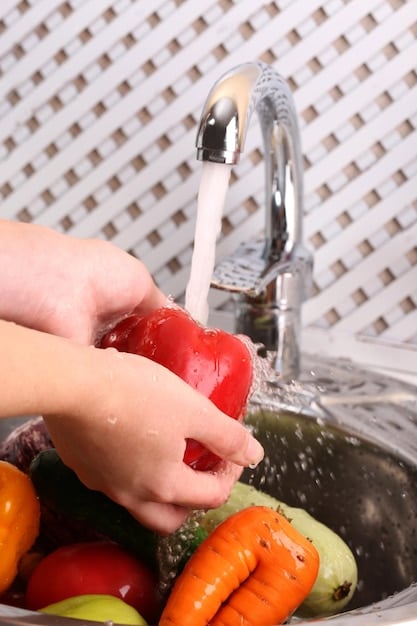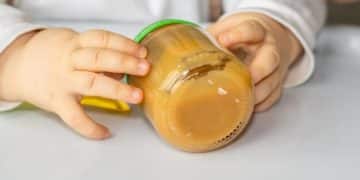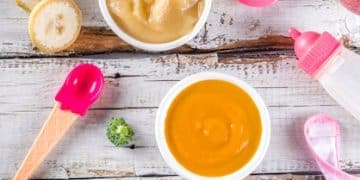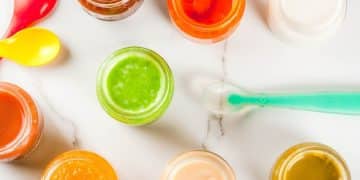Organic vs. Non-Organic Baby Food: Is It Worth the Extra 15%?

Deciding between organic and non-organic baby food involves weighing potential benefits like reduced pesticide exposure against the slightly higher cost, typically around 15%, to ensure the best start for your baby’s health.
Choosing the right food for your baby can be overwhelming, especially when considering the options of organic vs. non-organic baby food: is it worth the extra 15%? This decision involves understanding the differences in ingredients, potential health benefits, and of course, the impact on your wallet.
Understanding Organic Baby Food
Organic baby food has become increasingly popular among parents, but what does “organic” really mean? It’s about more than just a label; it signifies a specific approach to farming and food production.
Let’s dive a bit deeper into the key aspects of organic baby food and what makes it different.
What “Organic” Means
When a baby food product is labeled “organic,” it means that it has been produced according to specific standards set by regulatory bodies like the USDA (in the United States). These standards dictate how the food is grown, processed, and handled.
- No Synthetic Pesticides or Fertilizers: Organic farming prohibits the use of synthetic pesticides, herbicides, and fertilizers. Instead, farmers rely on natural methods to control pests and enrich the soil.
- No Genetically Modified Organisms (GMOs): Organic foods cannot be produced using genetically modified organisms.
- Sustainable Farming Practices: Organic farming promotes practices that are environmentally sustainable, such as crop rotation, composting, and conservation of water and soil.
These practices aim to create a healthier, more sustainable food system, reducing the potential for harmful chemicals to end up in your baby’s food.

In conclusion, organic baby food represents a commitment to natural, sustainable farming practices that avoid synthetic pesticides, GMOs, and harmful chemicals. This approach seeks to provide a safer, healthier start for your baby.
The Benefits of Choosing Organic
Choosing organic baby food often comes with the expectation of added health benefits. But what exactly are these benefits, and are they significant enough to justify the extra cost?
Let’s explore some of the key advantages associated with feeding your baby organic food.
Reduced Pesticide Exposure
One of the primary reasons parents choose organic baby food is to minimize their baby’s exposure to pesticides. The developing bodies of infants and young children are particularly vulnerable to the harmful effects of these chemicals.
Choosing organic food can significantly reduce this risk. Studies have shown that children who eat organic foods have lower levels of pesticide metabolites in their urine.
- Lower Risk of Chemical Exposure: Organic farming practices ensure that synthetic pesticides are not used, lowering the risk of chemical exposure.
- Healthier Neurological Development: Reducing exposure to pesticides can support healthier neurological development in infants.
- Reduced Risk of Long-Term Health Issues: Minimizing pesticide exposure early in life may reduce the risk of certain long-term health issues.
By opting for organic, parents can take a proactive step in protecting their children from potential harm.
Higher Nutrient Content
Some studies suggest that organic foods may contain higher levels of certain nutrients compared to their non-organic counterparts. While the evidence is not conclusive, there are indications that organic produce may be richer in antioxidants, vitamins, and minerals.
For example, organic fruits and vegetables may have higher levels of Vitamin C and certain antioxidants.
In summary, the benefits of choosing organic baby food include reduced pesticide exposure and potentially higher nutrient content. While the nutritional advantages are still debated, the reduction in harmful chemicals is a clear and compelling reason for many parents to choose organic.
Understanding Non-Organic Baby Food
Non-organic baby food, also known as conventional baby food, is produced using standard agricultural practices. It’s important to understand what these practices involve and how they differ from organic methods.
Let’s delve into the details of non-organic baby food production.
Conventional Farming Practices
Conventional farming relies on synthetic pesticides, herbicides, and fertilizers to maximize crop yields and control pests. While these practices can increase efficiency, they also raise concerns about potential health and environmental impacts.
Non-organic farming can use pesticides that may leave residues on crops. These residues are regulated by governmental bodies, but some parents still worry about their potential effects on infants.
- Use of Synthetic Pesticides and Fertilizers: These are used to protect crops from pests and promote growth.
- GMOs: Genetically modified crops may be used to enhance productivity and resistance to pests.
- Large-Scale Production: Often involves large-scale monoculture farming, which can deplete soil nutrients.
It’s also worth noting that non-organic farming is often more cost-effective, which translates to lower prices for consumers.
In conclusion, non-organic baby food is produced using conventional farming practices that rely on synthetic pesticides and fertilizers. While these methods can increase efficiency and lower costs, they also raise concerns about potential health and environmental impacts.
Potential Risks of Non-Organic Options
While non-organic baby food is generally considered safe, it’s important to be aware of the potential risks associated with conventional farming practices.
Let’s explore some of these risks in more detail.
Pesticide Exposure
One of the main concerns with non-organic baby food is the potential for pesticide exposure. Even though pesticide levels are regulated, infants and young children are more vulnerable to the effects of these chemicals due to their developing bodies.
Some studies have linked pesticide exposure to developmental issues, neurological problems, and even certain types of cancer.
- Residues on Food: Non-organic crops may have residues of synthetic pesticides.
- Potential Health Impacts: Exposure to pesticides can potentially affect neurological development and increase the risk of certain health issues.
- Vulnerability of Infants: Infants and young children are more susceptible to the harmful effects of pesticides.
Parents who choose non-organic baby food should be aware of these risks and take steps to minimize exposure, such as thoroughly washing fruits and vegetables.

GMO Concerns
Genetically modified organisms (GMOs) are another concern for some parents. While the scientific community generally agrees that GMOs are safe to eat, some people worry about potential long-term health effects.
Conventional farming often uses GMO crops, which can be a concern for parents seeking to avoid genetically modified foods.
In summary, potential risks associated with non-organic baby food include pesticide exposure and concerns about GMOs. While these risks are generally considered low, parents should be aware of them and take steps to minimize potential harm.
Cost Comparison: Organic vs. Non-Organic
One of the biggest factors in deciding between organic and non-organic baby food is cost. Organic options tend to be more expensive, but how much more are we talking about?
Let’s break down the cost comparison to help you make an informed decision.
Price Differences
On average, organic baby food can cost about 15% more than its non-organic counterpart. This price difference can add up over time, especially if you are buying a lot of baby food.
The higher cost of organic food is due to several factors, including stricter farming practices, lower yields, and higher labor costs.
- Organic baby food is more expensiveDue to stricter standards.
- More labor intense than Non-organic baby food process.
When budgeting for baby food, it’s important to consider these price differences and decide what is most important for your family.
Budget-Friendly Tips
If you want to feed your baby organic food but are concerned about the cost, there are several strategies you can use to save money.
One option is to make your own baby food at home. This allows you to control the ingredients and ensure that you are feeding your baby organic food at a lower cost.
- Buy in Bulk: Purchasing larger quantities can often reduce the per-unit cost.
- Make Your Own Baby Food: This can be significantly cheaper than buying pre-made organic options.
- Look for Sales and Coupons: Keep an eye out for discounts and special offers on organic baby food.
By implementing these tips, you can make organic baby food more accessible and affordable.
In conclusion, while organic baby food typically costs more than non-organic options, the price difference can be manageable with careful budgeting and smart shopping strategies. Balancing cost with your health priorities is key to making the right choice for your family.
Making the Right Choice for Your Baby
Choosing between organic and non-organic baby food is a personal decision. There is no one-size-fits-all answer, and what is right for one family may not be right for another.
Let’s consider the key factors that can help you make the best decision for your baby.
Consider Your Priorities
Think about what is most important to you when it comes to your baby’s food. Are you primarily concerned about minimizing pesticide exposure, or is cost your biggest consideration?
Understanding your priorities can help you weigh the pros and cons of each option and make a more informed choice.
- Health Concerns: If you are concerned about pesticide exposure and potential long-term health effects, organic may be the better choice.
- Budget Limitations: If cost is a major concern, non-organic baby food can be a more affordable option.
- Environmental Concerns: If you value sustainable farming practices, organic food supports environmentally friendly agriculture.
It’s also helpful to discuss your concerns with your pediatrician or a registered dietitian, who can provide personalized advice based on your baby’s specific needs.
Ultimately, the decision of whether to choose organic or non-organic baby food depends on your individual priorities, values, and budget. By carefully considering these factors and staying informed, you can make the best choice for your baby’s health and well-being.
| Key Point | Brief Description |
|---|---|
| 🌱 Organic Baby Food | Produced without synthetic pesticides, GMOs, or fertilizers. |
| 💰 Cost Difference | Organic baby food typically costs around 15% more than non-organic. |
| ✅ Benefits of Organic | Reduced pesticide exposure and potentially higher nutrient content. |
| ⚠️ Risks of Non-Organic | Potential pesticide exposure and GMO concerns. |
Frequently Asked Questions
▼
Organic baby food reduces pesticide exposure, but nutrient levels can vary. Check labels and consult a pediatrician for balanced nutrition.
▼
Consider making your own baby food from organic produce, buying in bulk, and looking for sales or coupons on organic brands.
▼
The scientific consensus is that GMOs are safe, but some parents prefer to avoid them. Organic baby food is GMO-free.
▼
Look for certifications from reputable organizations such as the USDA Organic, which ensures the food meets strict organic standards.
▼
Yes, making your own baby food from organic fruits and vegetables is a cost-effective and healthy way to ensure quality ingredients.
Conclusion
In the debate of organic vs. non-organic baby food: is it worth the extra 15%?, the answer depends on your priorities and values. Organic options offer reduced pesticide exposure and support sustainable farming practices, while non-organic choices are more budget-friendly. By weighing these factors and staying informed, you can make the best decision for your baby’s health and your family’s needs.





